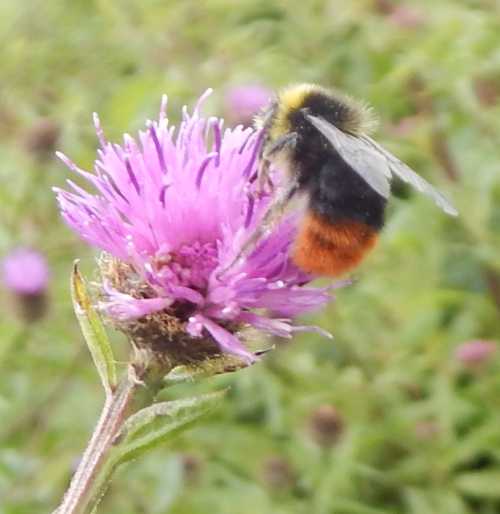Bombus lapidarius -
Red-tailed Bumble Bee
Bombus lapidarius (the Red-tailed bumble bee), is one of Britain’s relatively common species of bumble bee, and is distributed widely throughout the British Isles.
About Bombus lapidarius
Although all bumble bees are regarded as long-tongued, in comparison with other bumble bees, this species has a short to medium length tongue.
It is a social species, rather than a parasitic cuckoo bumble bee species such as Bombus rupestris, which can be mistaken for this species.
Other species of British bumble bee similar to the red-tailed, include Bombus ruderarius and Bombus monticola, both of which are social bumble bees.
Queen
Queen Red-tailed bumble bees can be quite large – up to 22mm in length. I’m not sure if it is clear to readers from this photograph below, but the black short hair is almost velvety in appearance.
This queen pictured, is foraging on grape hyacinth (Muscari), a good source of food for bees in early spring.
 Bombus lapidarius queen
Bombus lapidarius queen
Workers
Worker Red-tailed bumble bees are variable in size. They can be smaller than the queen and resembling her, but sometimes they can be quite tiny! During my talks about bees, I often compare very small worker Bombus lapidarius with the size of my little finger nail, which is only about 12mm in length.
 Above, a Bombus lapidarius worker foraging on bird's foot trefoil.
Above, a Bombus lapidarius worker foraging on bird's foot trefoil.
Males
Males are smaller than the queens, and most commonly have a yellow band on the collar, and a tuft of yellow on the face. Red hairs are sometimes apparent on the hind legs in males.
 Bombus lapidarius male on knapweed flower
Bombus lapidarius male on knapweed flower
Bombus lapidarius lifecycle
Queens may emerge in March-April, although in some parts of the country, they have been observed to appear as early as mid February depending on weather conditions.
They typically
prospect for nests in grassland, wooded areas, scrub land, and may be seen
inspecting small hollows in the ground and grassy turfs.
However, along with other species of bumble bee, Red-tailed bumble bees have adapted to the increasing shortage of natural nest sites, and they have been observed to establish nests in abandoned bird boxes.
Colony size
Colonies are thought to reach about 300 workers by early
to mid- summer, and new queens and males are seen from around June onwards. Newly impregnated queens that have built up
their body fats, typically hibernate underground in loose soil.
Interestingly, Bombus lapidarius is one of the bumble bee species especially associated with egg eating behaviours by workers1.
The nests of this species are targeted by the cuckoo, Bombus rupestris.
Plants for Red-tailed bumble bees
As this bumble bee emerges fairly early in the season, it’s good to include a variety of spring flowering plants and shrubs in your garden to attract this species, and also to help queens re-fuel after hibernation, as well as establish their colonies.
Plants and shrubs beneficial to Red-tailed bumble bees include berberis, broom, bluebell, crocus, mahonia, erica cultivars, flowering currant, blackthorne.
They also enjoy
dandelions, gorse, red and white dead nettles, ground ivy, vetches, bird’s foot
trefoil.
For summer, include thyme, lavatera, sedum, sage, poppy, teasel, laburnum, ceanothus, chive, wallflower, dahlia, clovers, purple loosestrife, marjoram, aster, comfrey, borage, and hebe.
They also enjoy self-heal,
knapweed, woundworts, mallows, brambles, thistles, burdock, willow herb, viper’s
bugloss, heathers, ragwort and cat’s ears.
References
(1) Free, J. B., et al. “The Egg-Eating Behaviour of Bombus Lapidarius L.” Behaviour, vol. 35, no. 3/4, 1969, pp. 313–317. JSTOR, www.jstor.org/stable/4533313. Accessed 2 May 2021.


